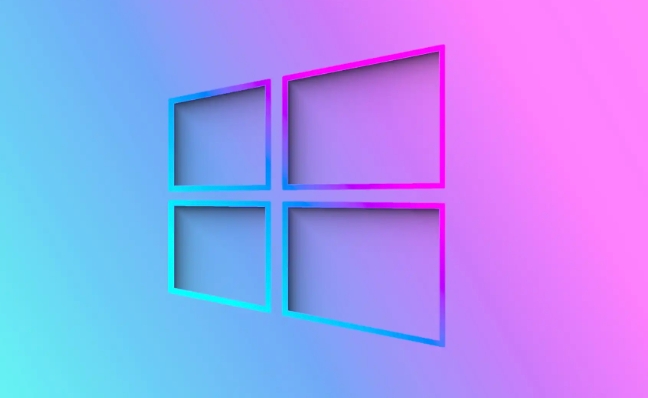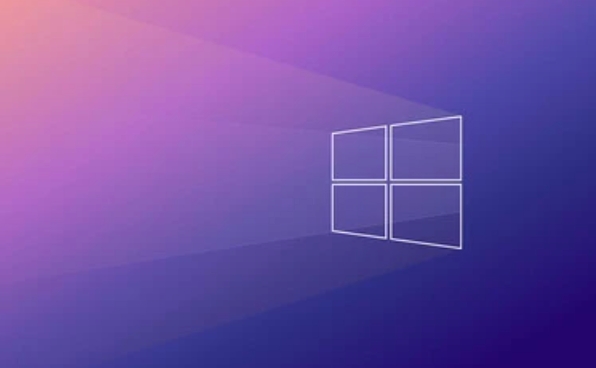How to fix 'PAGE_FAULT_IN_NONPAGED_AREA' BSOD in Windows
When encountering the "PAGE_FAULT_IN_NONPAGED_AREA" blue screen error, you can follow the following steps to troubleshoot: 1. Update or roll back the key device drivers, and give priority to using the official drivers; 2. Use Windows memory diagnostic tools or MemTest86 to detect memory problems; 3. Run SFC, DISM and chkdsk commands to fix system file and disk errors; 4. Uninstall recently installed software or system updates. In most cases, the above method can be solved. If it is invalid, you need to consider reinstalling the system or detecting hardware failures.

"PAGE_FAULT_IN_NONPAGED_AREA" is one of the common blue screen errors in Windows systems, usually happening when the system accesses a memory area that should not be paging. This problem may be caused by driver, hardware issues, or system files corruption. If you encounter this blue screen error, here are some practical and effective solutions.

1. Update or rollback the driver
Driver incompatibility is a common cause of this error, especially drivers of key devices such as graphics cards, hard disk controllers, or network cards.

- Check driver updates : Open "Device Manager", find the relevant hardware (such as display adapter, storage controller), and right-click to select "Update Driver".
- Rollback the driver version : If a blue screen appears after the driver has been updated recently, you can try to fall back to the previous version.
- Use official drivers : Avoid using general drivers automatically installed by Windows. It is recommended to download and install special drivers from the official website of the device.
Sometimes, drivers that come with third-party antivirus software or virtual machine tools can also cause conflicts, and it may be helpful to uninstall or update the driver components that come with these software.
2. Check memory (RAM) issues
Because this error is related to memory access, memory module failure or instability can also be the culprit.

-
Use Windows built-in Windows memory diagnostic tool :
- Press Win R, enter
mdsched.exe, and select Restart Now and Check for Problems. - After the system restarts, memory problems will be automatically detected and the results will be prompted after the next startup.
- Press Win R, enter
If you have multiple memory modules, you can try to unplug and test one by one to troubleshoot the problem of corruption of a memory module.
You can also use tools such as MemTest86 for more in-depth testing, which requires making a USB drive startup disk.
3. Scan system files and disk errors
Corrupt system files or bad hard drives can also cause such blue screens.
-
Run SFC scan :
- Open a command prompt as an administrator and enter:
sfc /scannow
- It will scan and repair system critical files.
- Open a command prompt as an administrator and enter:
Run the DISM command (if SFC cannot be fixed):
DISM /Online /Cleanup-Image /ScanHealth DISM /Online /Cleanup-Image /RestoreHealth
Check for disk errors :
chkdsk C: /f /r
(Note: C: It is your system disk, and it needs to be restarted after execution)
4. Uninstall recently installed software or updates
If you start encountering blue screens after installing certain software or system updates, it is most likely that they cause conflicts.
- Try entering safe mode and uninstall recently installed software or updates.
- Click "View installed updates" in Control Panel > Programs and Features to uninstall the most recent KB patches.
- Pay special attention to whether unofficial optimization tools and driver management software (such as some cleaning software) are installed.
Basically, these common investigation directions are all about these common investigations. Although this error seems scary, it can be solved in most cases by updating the driver, checking memory, and repairing system files. If none of the above methods work, you may want to consider reinstalling the system or checking whether there is any problem with the motherboard/memory hardware.
The above is the detailed content of How to fix 'PAGE_FAULT_IN_NONPAGED_AREA' BSOD in Windows. For more information, please follow other related articles on the PHP Chinese website!

Hot AI Tools

Undress AI Tool
Undress images for free

Undresser.AI Undress
AI-powered app for creating realistic nude photos

AI Clothes Remover
Online AI tool for removing clothes from photos.

Clothoff.io
AI clothes remover

Video Face Swap
Swap faces in any video effortlessly with our completely free AI face swap tool!

Hot Article

Hot Tools

Notepad++7.3.1
Easy-to-use and free code editor

SublimeText3 Chinese version
Chinese version, very easy to use

Zend Studio 13.0.1
Powerful PHP integrated development environment

Dreamweaver CS6
Visual web development tools

SublimeText3 Mac version
God-level code editing software (SublimeText3)
 What to do with BSOD error code 0xc0000001 in Win11 system
Jul 02, 2023 am 08:13 AM
What to do with BSOD error code 0xc0000001 in Win11 system
Jul 02, 2023 am 08:13 AM
What to do with BSOD error code 0xc0000001 in Win11 system? In our daily use of computers, we will inevitably encounter computer problems, large and small. Recently, some users have encountered the BSOD error code 0xc0000001, which is very troublesome. For this, the editor has prepared a solution below. We will Get up and take a look. Solution steps for Win11 system BSOD error code 0xc0000001 Perform startup repair in Recovery mode 1. First, create bootable media for Windows 11 and use the media to boot the PC. 2. On the next screen, click Repair your computer. 3. You will now reach the system recovery options screen. 4. When choosing one
 Linux is getting Blue Screen of Death for kernel panic
Jun 24, 2024 pm 06:47 PM
Linux is getting Blue Screen of Death for kernel panic
Jun 24, 2024 pm 06:47 PM
Late last year, version 255 of the Linux system management service systemd was given the ability to display Blue Screen of Death (BSOD) style error messages in full-screen mode. However, this solution does not work for kernel errors, so the upcoming
 How to fix 'PAGE_FAULT_IN_NONPAGED_AREA' BSOD in Windows
Jul 04, 2025 am 02:50 AM
How to fix 'PAGE_FAULT_IN_NONPAGED_AREA' BSOD in Windows
Jul 04, 2025 am 02:50 AM
When encountering the "PAGE_FAULT_IN_NONPAGED_AREA" blue screen error, you can follow the following steps to troubleshoot: 1. Update or roll back the key device drivers, and give priority to using the official drivers; 2. Use Windows memory diagnostic tools or MemTest86 to detect memory problems; 3. Run SFC, DISM and chkdsk commands to repair system file and disk errors; 4. Uninstall recently installed software or system updates. In most cases, the above method can be solved. If it is invalid, you need to consider reinstalling the system or detecting hardware failures.
 How to fix the Blue Screen of Death (BSOD) in Windows?
Jul 09, 2025 am 12:25 AM
How to fix the Blue Screen of Death (BSOD) in Windows?
Jul 09, 2025 am 12:25 AM
Blue Screen of Death (BSOD) is usually caused by hardware, driver or system file problems. You can troubleshoot and fix it through the following steps: 1. Check the recently installed hardware or driver, uninstall or roll back unstable devices; 2. Run sfc/scannow, DISM, chkdsk and other tools to scan system files and disk errors; 3. Use memory diagnostic tools to test memory failures; 4. Update the system and analyze the problem of positioning specific modules in the blue screen log. In most cases, it can be solved through gradual investigation.
 page fault in nonpaged area Windows BSOD
Jul 05, 2025 am 01:14 AM
page fault in nonpaged area Windows BSOD
Jul 05, 2025 am 01:14 AM
The common causes and solutions to the "pagefaultinnonpagedarea" blue screen error are as follows: 1. Driver or software conflicts, it is recommended to enter safe mode to uninstall recently installed drivers or software, especially unofficial drivers; 2. Memory problems, use Windows memory diagnostic tools or MemTest86 to detect and try to re-plug and unplug the memory module; 3. System files are corrupted, run sfc/scannow and DISM commands to repair system files; 4. Others may include updating the BIOS, checking the bad hard disk, turning off overclocking settings, etc. In most cases, the above steps can be used to locate and solve the problem.
 How to fix R.E.P.O. causing blue screen of death (BSOD) errors
Aug 15, 2025 am 06:47 AM
How to fix R.E.P.O. causing blue screen of death (BSOD) errors
Aug 15, 2025 am 06:47 AM
IfBSODiscausedbyR.E.P.O.,trythesesteps:1.UninstallR.E.P.O.software.2.DisablerelateddriversinDeviceManager.3.Performacleanboot.4.Updateorrollbackdrivers.5.RunSFCandDISMtorepairsystemfiles.
 my win pc is not creating a crash dump file (memory.dmp) after a bsod
Aug 01, 2025 am 05:07 AM
my win pc is not creating a crash dump file (memory.dmp) after a bsod
Aug 01, 2025 am 05:07 AM
First,ensurecrashdumpsettingsarecorrectlyconfiguredinSystemPropertiesbysettingthewritedebugginginformationtoSmall,Kernel,orCompleteMemoryDumpandconfirmingthepathisvalid,asincorrectsettingspreventdumpcreation.2.Next,verifythesystemdrivehassufficientfr
 Resolving the CLOCK_WATCHDOG_TIMEOUT BSOD in Windows
Aug 06, 2025 am 07:47 AM
Resolving the CLOCK_WATCHDOG_TIMEOUT BSOD in Windows
Aug 06, 2025 am 07:47 AM
First check and turn off the overclocking settings, enter BIOS/UEFI to disable XMP, DOCP or AITweaker and other options, and restore the default settings to eliminate stability issues; 2. Update or roll back the driver, update the drivers of the processor, chipset and storage controller through the device manager. If the problem occurs after the update, use the "fallback driver" function in the driver properties; 3. Run hardware diagnostics, use Prime95 or IntelBurnTest for CPU stress tests, use HWMonitor to monitor the temperature, run Windows memory diagnostics or MemTest86 to detect memory, use CrystalDiskInfo to check disk health status; 4. Update BIOS/U







